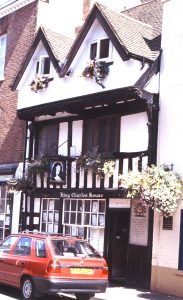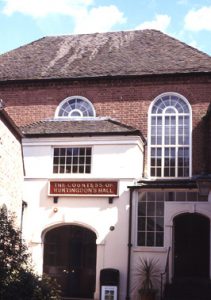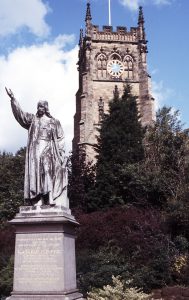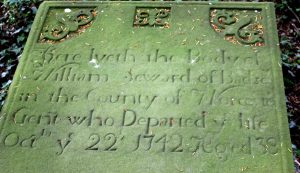Hereford & Worcester
WORCESTER

Worcester Cathedral and River Severn
The view of Worcester Cathedral as a backdrop to the county cricket ground, with the river Severn running by, forms the quintessential image of an English cathedral city. The tomb of King John, reluctant signatory of Magna Carta, is here, as is that of Prince Arthur, elder brother of Henry VIII. It was Arthur's marriage to Katherine of Aragon, his early death and Henry's subsequent marriage to his widow that provided the opening scenes of a drama now played out in endless films and television serials. It precipitated Henry's break with Rome and changed the course of English history.

King Charles House
Over a century later another turning point in history was fought out in the streets of Worcester, when the future Charles II was defeated in the final battle of the Civil War in 1651. He narrowly avoided the fate of his father by escaping from a house, which can still be seen in New Street (WR1 2DP), as Cromwell's troops stormed in at the front. After many adventures he found refuge in France and returned in triumph at the Restoration of the monarchy in 1660.
The cathedral stands in its own delightful close, high enough above the river Severn to escape the regular flooding. Water levels in various flood years are marked on a wall by the riverside footpath. With its cloisters, crypt and vaulted chapter house, the present building has all the essential features of a medieval cathedral. Two bishops from the Saxon period and two others at the time of the Reformation deserve particular mention.
The oldest part of the present cathedral is the crypt, built during the long bishopric of St Wulfstan (born 1008). It dates from 1084 and can be reached from the main body of the cathedral or by a separate entrance on the north side. It is much as it was in Wulfstan's time, except that heavy stone blocks were added to support the extra weight of the Lady Chapel and Quire built in the thirteenth century. On his death in 1095, Wulfstan was buried in his cathedral but the main part of that building was destroyed by fire in 1113.
Wulfstan entered the monastery at Worcester and successively held the positions of schoolmaster, precentor, sacristan and prior. He was appointed bishop in 1062 and remained in office until his death over thirty years later. This covered that watershed in English history, 1066, and Wulfstan was the only Saxon bishop not to be replaced by a Norman. He had supported Harold, but after the Battle of Hastings counselled submission to the Normans and assisted at the coronation of William the Conqueror. He travelled constantly in his diocese, preaching, exhorting and promoting church building. On visits to Bristol, he suppressed a flourishing slave trade with Ireland. Respected by all sides, he helped to smooth the transition from Saxon to Norman rule, which in many parts of the country had violent and bloody consequences. Between 1084 and 1089 he organised the rebuilding of the cathedral.
In the century before Wulfstan, St Dunstan (924-988) became bishop in 957 but stayed only three years before being appointed Archbishop of Canterbury. He probably spent little time in Worcester as other duties demanded his presence elsewhere. He acted as statesman and adviser to a succession of Saxon kings at a time of great political instability. He was counsellor to King Edmund, then treasurer and chief adviser to his successor Edred. Under King Edgar of Mercia, he carried out a complete reform of church and state and revived monastic life in England. This continued when Edgar was succeeded by King Edward the Martyr in 975, and he crowned Ethelred king on Edward's death in 978.
Two bishops of Worcester from the Reformation period were Hugh Latimer (c1481-1555) and John Hooper (1495-1555), but neither has a memorial here. Both men were convinced Protestants and both perished as martyrs to Queen Mary's unforgiving brand of catholicism. Hooper was bishop from 1552 to 1553, combining this office with that of Bishop of Gloucester, where he died at the stake in front of his cathedral.

Huntingdon Hall
Latimer served as rector of West Kington in Wiltshire before being appointed bishop in 1535. He ordered all priests in his diocese to have the Bible in English and suppressed the worship of images. At the Dissolution, he appealed unsuccessfully to Thomas Cromwell to allow some monastic buildings to be put to other uses. In 1539, he refused to sign the Six Articles, which upheld certain Roman Catholic doctrines, and resigned his bishopric. On the accession of Mary in 1553, he was arrested and eventually died alongside fellow bishop Nicholas Ridley at Oxford.
In Deansway, close to the Cathedral, is one of the few surviving chapels of the Countess of Huntingdon's Connexion. Set back from the street in a little courtyard, it is now called Huntingdon Hall and is in secular use. The chapel was founded in 1773 and supplied by students from the Countess's college at Trevecca, in Wales. A new building was erected in 1804 and was further enlarged in 1815.
KIDDERMINSTER
It is memories of Richard Baxter (1615-1991), one of the best loved writers and pastors from the Puritan period, that bring us to this bustling town, once the centre of the carpet weaving industry.

Baxter statue and St Mary's Church
Baxter was born, brought up and served his first curacy in Shropshire, but his time in Kidderminster between 1641 and 1660 transformed the spiritual life of the town and has often been cited as an example of an outstanding pastoral ministry. He came as "lecturer" to the incumbent vicar of St Mary's Church, whose drunkenness had attracted the attention of the Long Parliament, which was trying to reform the clergy. It was said that when Baxter came, there was hardly one home in each street where God was worshipped, but when he left, there were some streets with scarcely a house where God was not worshipped. His own problems with ill health gave him a sound knowledge of "physic", and for several years he served as the town's doctor as well as its pastor.
Baxter's statue, erected in 1875, stands in a little garden beside the busy Ringway, with St Mary's high on a rocky outcrop just behind. His arm is raised in exhortation and the inscription records that he was renowned equally for his Christian learning and his pastoral fidelity. Five galleries had to be added in the church to accommodate the people who flocked to hear him preach. Despite its impressive setting and well maintained grounds, St Mary's today does not seem to be used for regular worship. Inside, a pillar has marks where Baxter's pulpit was fastened and his oak chair is still kept in the sanctuary.
When Baxter left the town in 1660, he entrusted the care of his flock to Thomas Baldwin, the first minister of what is now the Baxter United Reformed Church (DY10 2DG). Situated in the Bull Ring at the heart of the town, the present building is the fourth to occupy the site and was built of local red sandstone in 1885. The church uses Baxter's table as their communion table and has several portraits.

Richard Baxter's pulpit
A few yards away at the bottom of Church Street is the Unitarian New Meeting, which also houses a small carpet museum called The Weaver's Loft (DY10 2AY). About two hundred years ago, this church acquired Baxter's beautiful canopied pulpit, then lying abandoned in St Mary's churchyard. Fully restored, it has the date 1621 and the text Praise the Lord and call upon his name, and declare his works among the people is inscribed in gold letters around the canopy. The New Meeting also has a first edition of Baxter's complete works beautifully bound in four enormous volumes.
Baxter's ministry in Kidderminster covered the whole period of the Civil War and Commonwealth, when it was hard to be neutral on matters of politics and religion. He did not oppose the principle of monarchy, but sided with Parliament and had to flee when Worcestershire supported the King. For a time he served as chaplain to a Parliamentary regiment, but the rigors of military life led to frequent bouts of illness and in 1647, he spent several months recuperating in the village of Rous Lench.
Baxter supported the restoration of the monarchy and was even appointed a chaplain to Charles II and offered a bishopric. Between 1660 and 1662, he spent much time preaching in London, but with the Act of Uniformity in 1662 he found himself a Dissenter. Excluded from the Church of England, he continued to preach and was imprisoned in 1685 and 1686. He supported the accession of William and Mary in 1688 and the Toleration Act that followed gave him some rest in his final years. Baxter was renowned for his prolific literary output and has been described as the creator of popular Christian literature.
ASTLEY
Daughter of William Henry Havergal, rector of Astley and an authority on church music, the hymnwriter Frances Ridley Havergal (1836-1879) was born here and was buried at St Peter's Church at the end of her short life. Her grave is at the west end of the churchyard, close to the road (DY13 0RN).
Frances showed precocious talent, reading at the age of four and soon proficient in French and music. When the family moved to a new parish in Worcester, she attended school and also experienced conversion, embracing the strong evangelical convictions which characterised her writings. In 1853, she travelled with her father in Germany, gaining a sound knowledge of several European languages and also Greek and Hebrew.
She published several volumes of hymns and poetry, with a strong devotional style which which was popular in late Victorian times but less fashionable today. The hymn that has best stood the test of time is Take my life and let it be consecrated Lord to thee. Always in delicate health, she died at the age of 42, while staying with her sister at Caswall Bay, Swansea.
ROUS LENCH

Rous Lench Court
On the A422 between Worcester and Alcester, a signpost directs us to "The Lenches", a group of villages sharing that name. Rous Lench Court (WR11 4UL) is a splendid house at the southern end of the village, still privately owned. Much changed over the centuries, it is now an eclectic mixture of black and white gables, ornate chimneys and yew hedges. On an arch over the entrance are the words Welcome ye coming, and speed ye parting guests. The welcome guest here in 1647 was Richard Baxter, reduced almost to death by illness and hardships as a chaplain in Cromwell's army. His hosts were Sir Thomas and Lady Rous who lovingly cared for the puritan pastor for several months until he was well enough to return to Kidderminster. While here he found time to put together thoughts and meditations which became his first and best known book The Saint's Everlasting Rest.
CUSOP

William Seward's grave
The village lies close to the Welsh border some twenty miles west of Hereford in remote and beautiful country. Beneath a yew tree in the churchyard of St George's Church (HR3 5RF) is the grave of William Seward (1711-1740), one of the few actual martyrs of the evangelical revival. Seward had joined George Whitefield on his second journey to America and on his return resumed open air preaching. However, he seemed to lack the gifts required to deal with unruly mobs and was virtually blinded by stones hurled during a meeting at Caerleon in Wales. A month later at Hay-on-Wye, a similar attack proved fatal. His gravestone has the simple text For me to live is Christ, to die is gain. It gives the date of his death as 1742; it was actually two years earlier.


